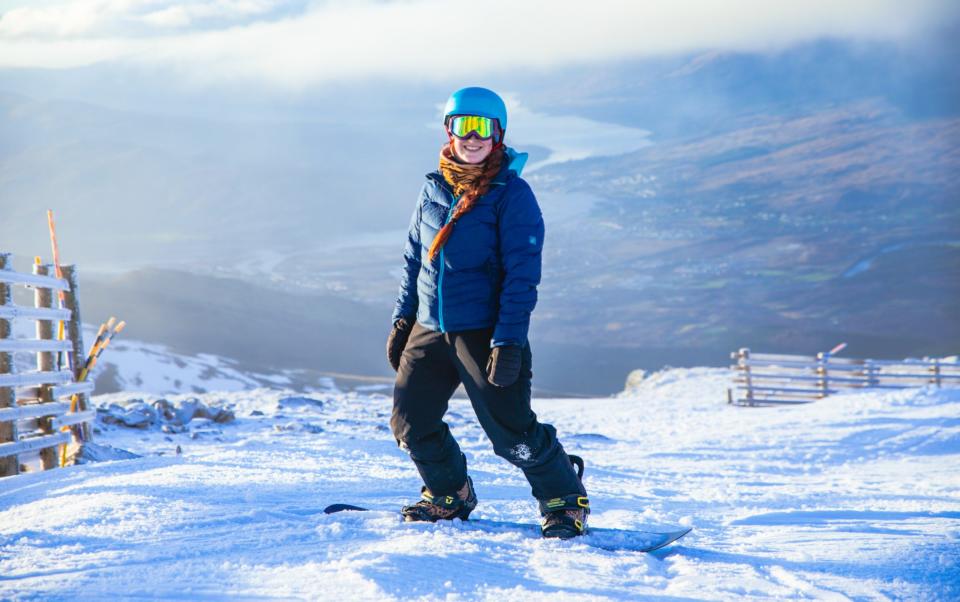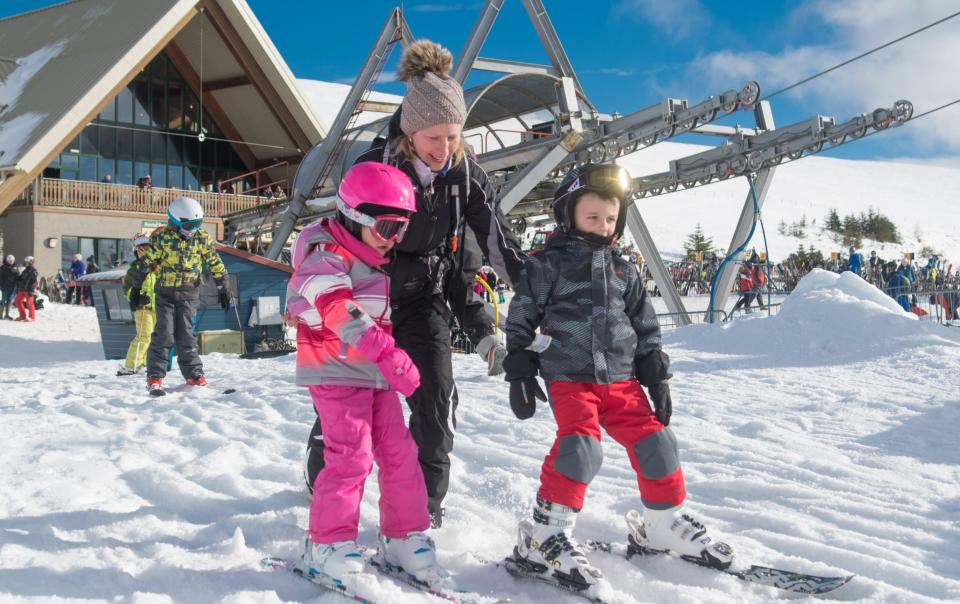The ultimate guide to skiing in Scotland this winter

Glencoe at dawn on a freezing morning in February 1956 presented to the world a very different idea of the Highlands. Up until then, the north-facing slopes of Meall a’Bhuiridh were the sole domain of winter sports pioneers. All bound by the common thread of mountain adventure, they’d hike to the summit in breeches and flat caps, carrying wooden boards with leather strap bindings.
But that winter – after a summer of hard graft and a cost of £5,000 (£154,000 today) – the first fixed ski tow in Scotland was opened and the mountain became a purely inviting space. One on which to ski white corries, discover steep runs and find new meaning in a Scottish winter.
In the decades since, winter sports in Scotland have snowballed into a small triumph. Today, there are five ski centres – Glencoe, Glenshee (opened in 1957), Cairngorm Mountain (1961), The Lecht (1977) and Nevis Range (1989) – and there is a raw beauty to it all. The brilliant quirk being that, with laid-bare hills, low-tech lifts, lack of red tape and loosely-marked piste maps, there’s nowhere else quite like it. It’s almost like looking back in time to a place cut off in the new world.
But let’s not get ahead of ourselves. This is Scotland, land of horizontal rain and glowering skies. The hills are softly modest, not wintry thickets of soaring peaks. There is less tourist brochure sunshine, more incensed wind (so much so, it’ll blow your bobble hat off; it’s probably no surprise to learn that diehards here have made zero concessions to the ski helmet industry). Besides that, swashbuckling across heather and bunny-hopping rock fields is fair game too.
Even so, each ski centre is terrific in its own way. They are easy to get to for plenty of Britons, mostly open from December to late April, and the thrill of jumping in the car at the 11th hour to be rewarded by sacred turns the following morning remains undiminished.
So, with the British weather turning wintery, should you be keen to give it a go – and you’d regret it if you didn’t – this guide will tell you everything you need to know about skiing in Scotland this winter.

Skip to your favourite resort:
Glencoe Mountain Resort
Best for experts
The mist-free summit views, more-or-less snow-sure gullies and its history make Glencoe feel sweepingly self-assured. On the A82, 90 minutes north-west of Glasgow, it’s the most accessible of Scotland’s Big Five meaning on a bluebird day it can feel unfairly busy.

In recent years, the base station restaurant and car park have been revamped and extended, while the three-person Rannoch Chairlift now eases queues and opens up the mid-mountain plateau terrain for beginners and intermediates.
That takes the mountain’s infrastructure to nine lifts, which play snakes and ladders across 20 rough-and-tumble runs that are as rip-roaring as Scotland gets. The Main Basin arrives fully formed as one of the most reliable in the country, even come late April; then there’s the Canyon, Haggis Trap and East Ridge, all kicky with revelations (or rude awakenings, if you take a nosedive). Then there is the 40-45 degree Flypaper. It’s so steep that anyone brave enough to tackle it is guaranteed almost absolute solitude.
Where to stay: The closest hotel is the legendary Kingshouse Hotel (kingshousehotel.co.uk), five minutes’ drive away and overlooking Rannoch Moor. Doubles from £125, including breakfast.
More information: glencoemountain.co.uk
Nevis Range
Best for facilities
When the ski centre opened on Aonach Mòr in the late 1980s to the north of Fort William in the West Highlands, it was a game-changer. Gondola? Quad chair? Backcountry lift in the almost-Alpine Back Corries? Look no further, but add to that list the Xanadu of Scottish off-piste skiing: the West Face. Besieged by incomparable views, its chanter-like chutes are sucker-punched by Ben Nevis and – better still, muscular Càrn Mòr Dearg – which means you could almost mistake the gnarly couloirs for La Grave or Verbier were it not for the granite crags ahead and heather below.

For those less inclined to high-stress environments, the ski map is drawn with some of the country’s most-wanted beginner terrain. For cruisey blues and greens, the runs that wiggle to and from the Snowgoose restaurant lead to enough piste to justify the most expensive lift ticket in the country.
Eventually, you’ll be sucked back down to the gondola basecamp, where there’s now an Alps-lite hotel, restaurant, shop and après-ski bar with gondola DJ booth. In the early days of Nevis Range, the focus was winter sports, pure and simple. That focus has now swung towards mountain biking and if the winter offering impresses, then you’ll arguably like it even more in the summer.
Where to stay: Next to the gondola station complex is the 26-bedroom Nevis Base Camp Hotel (nevisbasecamphotel.co.uk). Doubles from £80, room only.
More information: nevisrange.co.uk
Cairngorm Mountain
Best for families
In this eastern corner of the Highlands, life-changing experiences tend to begin and end in Cairngorms National Park. For skiers and snowboarders, that means daydreaming leads to the foot of the only mountain funicular in Britain, which takes five minutes to whizz 100 visitors per carriage from the ticket office and day lodge onto the wild habitat of Cairn Gorm.

This is a winter landscape as painted by JMW Turner, albeit one with a top station compound with restaurant, hands-on exhibition, ski gear shop, theatre with panorama film and craft gin bar. Out the swing doors is the ski area proper, with nearly a dozen lifts and two magic carpets, and it’s a toss-up between Coire na Ciste or Coire Cas for the country’s most developed (read: fenced) ski area.
As a popular tourist town, nearby Aviemore swells with hotels and restaurants, but fire-stoked pubs and a reindeer farm too. On stormbound days – or when the temperamental, repairs-hit funicular is out of action – the surrounding national park is a fresh-air freak’s dream; try cross-country skiing on pinewood trails at Glenmore or ice skating and curling on the town’s rink.
Where to stay: The bunkhouse at The Old Bridge Inn (aviemore-bunkhouse.com) has family rooms with bunks. Beds from £24.
More information: cairngormmountain.co.uk. Please not the funicular is currently closed for maintenance.
Glenshee
Best for size
Located almost midway between Blairgowrie and Braemar on the serpentine Snow Roads Scenic Route through Royal Deeside, Glenshee presents a meditation in landscape and the country’s largest ski area. With 25 miles of slopes and 22 retro T-bars and chairlifts flanking both sides of the A93, which threads its way up and over the Cairnwell Pass, there’s plenty going on. In fact, it seems widescreen pistes flow away from the ticket office and car park in every conceivable direction, with bowls, glades and narrow gullies.

Of all the ski runs to tackle, the banner waver is Glas Maol, a 1.2-mile Grand Prix with all the subtlety of an uppercut. Then there’s a rail park, beginners area and legendary Tiger – taken at speed, it’s a chance to almost fly above the highest A-road in Britain.
Where to stay: Turreted Dalmunzie Castle Hotel in the Spittal of Glenshee has rooms from £97 (dalmunzieestate.com). Or splash out at one of the best hotels in the country, the Fife Arms. Doubles from £314, include breakfast thefifearms.com
More information: ski-glenshee.co.uk
The Lecht
Best for beginners
If you’re after a ski area that could be said to best represent the country’s rudimentary appeal, your search will likely end here. What was opened in the north-eastern Cairngorms in the late 1970s as nothing more than a layby for three cars and a cattle grid is now a succession of short drag lifts, all of which lead back to the car park.

That makes it bliss for beginners. The majority of runs are easy greens and blues, with only one black piste likely to test those with Olympian thighs. In the spaces between are a snowboard park, tubing slope and travelators for the true punter.
Where to stay: Smugglers Hostel in the nearby village of Tomintoul is the highest accommodation in the Highlands and has a range of dorm beds and family rooms. From £25 per night thesmugglershostel.co.uk
More information: lecht.co.uk
Essential questions answered
What’s the snow like?
Whether your dreamlike conditions are fresh powder, spring snow, boilerplate, wind slab, crusty or mud and grass, Scotland’s ski centres have you covered. Often, days begin in frozen darkness, then spin through four seasons, with the snow conditions changing rapidly in time with the shifting weather and fluctuating temperatures. Which is to say, expect the worst, prepare for snow as good as the Alps, and accept that being on the mountain is its own reward. The Mountain Weather Information Service produces reliable forecasts (mwis.org.uk/forecasts/scottish). Winter Highland is also a great resource (winterhighland.info). The Telegraph’s weekly snow update also reports on the latest from Scotland.
When should I visit/book?
The rule of thumb when travelling to the Alps is to book in advance, but when it comes to skiing in Scotland that advice is for nothing. Snowfall is erratic at best, weather plays havoc with opening schedules, and the mountains certainly don’t feel any pity for screwing with your plans. Historically, February and March are the most reliable, but even the most committed local season ticket holders are sceptical about forecasts. Keep an eye on the snow report, be open to spontaneity and travel or book as late as you can.
How do I get there?
Not that winter sports are the most sustainable pastime, but skiing in Scotland is better for the environment than flying to the Alps. Which is to say, take the bus, train or hop in your car.
It’s not the Eurostar snow train, but if you are travelling from London Euston, consider a night on the Caledonian Sleeper to Fort William (departure 9.15pm Monday to Friday, 9pm Sunday, for Nevis Range; from £55/150 per seat/cabin, each way) or Aviemore (departure 9.15pm Monday to Friday, 9pm Sunday, for Cairngorm Mountain; from £55/150 per seat/cabin, each way). Note that onward transfers to the ski resorts cost extra – a taxi is the most efficient station-to-slope option. Find out more at sleeper.scot.
Otherwise, Scotrail (scotrail.com) and Citylink (citylink.com) both offer a comprehensive schedule of trains and buses across the Scottish Highlands, with most services departing from Aberdeen, Glasgow, Inverness and Edinburgh. Ellis Brigham Mountain Sports, in association with Clarkston Snowsports Club, runs a budget-friendly, weekend mountain shuttle from several stops in Glasgow to Glencoe Mountain, Nevis Range and Glenshee. Tickets cost £25, including £10 club membership fee (clarkstonsnowsports.co.uk).

Can I hire equipment and book lessons?
Gear rentals and snow sports lessons are available at all ski centres and booking in advance is highly recommended, particularly over weekends and holiday periods. With the focus very much on getting onto the mountain as early as possible on blue sky days – and available rental equipment limited – arranging your own gear in advance will save plenty of time and unnecessary stress.
Can I visit more than one resort?
Yes. Glencoe and the Nevis Range marry perfectly for a two-centre trip in the west, while Glenshee and The Lecht are highlights of the eastern Cairngorms. In one week, you could easily visit all five. And in good conditions, what a trip that would be.
Can I go ski touring or off piste?
Like elsewhere, ski touring is increasingly popular in Scotland, helping avoid lift queues and giving summit-busting access to harder-to-reach virgin pistes on the busiest of bluebird days. Touring equipment can be hired at Ellis Brigham Mountain Sports in Aviemore, Fort William and Braehead (ellis-brigham.com/equipment-hire-scotland). Always check the avalanche report in advance at Scottish Avalanche Information Service (sais.gov.uk).


